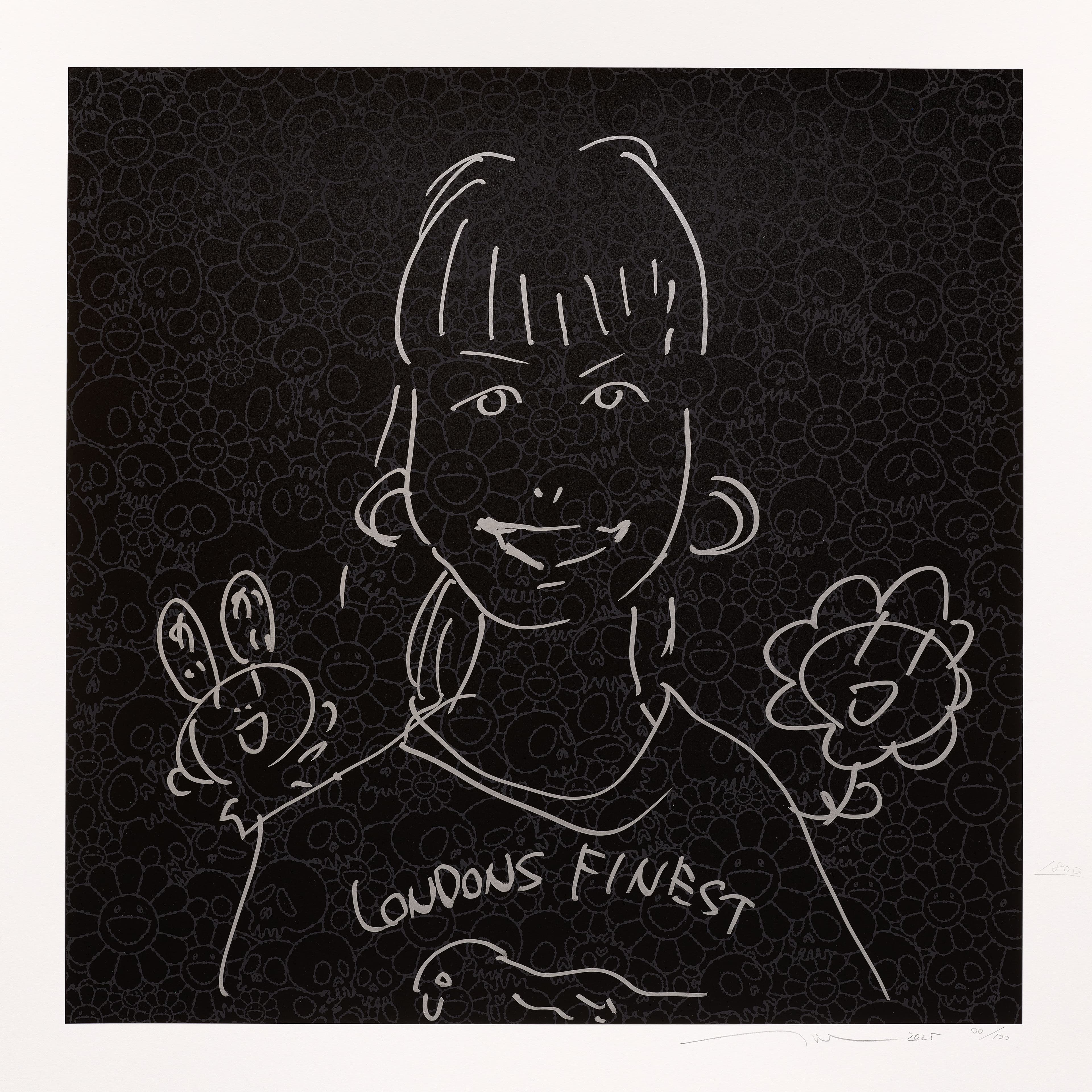Takashi Murakami: Stepping on the Tail of a Rainbow
This exhibition is presented by Akron Children’s.

- Special Exhibition
All tickets, including online and walk-ups, are sold out.
Guests to MIX: 90s Homecoming receive complimentary admission to Takashi Murakami: Stepping on the Tail of a Rainbow included with their ticket. Admission does not include access to the Yumedono.
The Kelvin and Eleanor Smith Foundation Exhibition Hall and GalleryATRM Atrium
Ames Family Atrium

© 2025 Takashi Murakami / Kaikai Kiki Co., Ltd. All Rights Reserved.
About The Exhibition
Discover an incredible exhibition of works from a Japanese artist known for his unique style that examines the cultural energies of contemporary Japan—anime, manga, and the otaku culture that grew around these popular art forms—against the backdrop of Japanese traditions. Takashi Murakami uses his art to interpret historical events and their lasting effects, such as the end of World War II, the 2011 Tōhoku earthquake and tsunami, and the COVID-19 pandemic.
Visitors can explore how—after shared traumatic events—art can address crisis, healing, outrage, and escapist fantasy. Artworks explore topics such as how people may change when experiencing trauma, how major disasters can lead to outpourings of creative and religious fervor, and how art addressing contemporary passions as diverse as gaming, the metaverse, trading cards, street fashion trends, anime, and manga can be an entry point to engaging the past.
The centerpiece of the exhibition is the re-creation of the Yumedono, or Dream Hall, from Nara Prefecture’s Hōryūji Temple complex in the Ames Family Atrium. The Yumedono is believed to occupy the same location as the home of Prince Shōtoku Taishi, who converted his father, Emperor Yōmei, to Buddhism in the late 500s CE by calling for Buddha to cure the emperor of an illness. Upon the emperor’s recovery, Buddhism was allowed formally into Japan. To this day, the Yumedono houses the Kuse Kannon (a likeness of Prince Shōtoku), which is believed to have the power to save people from suffering.
Originating at the Broad in Los Angeles, Takashi Murakami: Stepping on the Tail of a Rainbow is presented with expanded scope at the CMA.
Docent-guided tours are available on Wednesdays at 6:30 p.m. and Thursdays at 10:00 a.m. The tours are free to all ticket holders. Reserve a ticket for Murakami guided tours.
Private tours to Takashi Murakami: Stepping on the Tail of a Rainbow are also available to ticket holders, for $25 per 10 people. To schedule a tour, please contact grouptours@clevelandart.org or call 216-707-2752.
Docents are available on Fridays, Saturdays, and Sundays from 2:00 to 4:00 p.m. throughout the exhibition to answer questions and provide background information on the artworks. This service is free to all visitors in the exhibition.
Featured Art
Ticket Prices
Creating the Yumedono in 30 Days
Interventions Based on the CMA’s Permanent Collection
Discover four new Murakami artworks, inspired by a visit to the CMA:
- Homage to Museum Collection, Paul Cézanne, Mount Saint-Victoire Cezanne, located in gallery 222
- Homage to Museum Collection, Pierre Bonnard, The Dessert, located in gallery 223
- Prince Shōtoku at Age Two (Shōtoku Taishi), located in gallery 235B
- Surya, the Sun God, located in gallery 237
Murakami utilized 3D models produced by the CMA, along with the ability to remix and reuse them enabled by the open access policy, to digitally deconstruct and then reconstruct each selected artwork. From afar, Murakami’s works appear to be faithful copies of the originals; when viewed up close, visitors can see and recognize the discrepancies and are forced to adjust their mindset to the new works.

Hand-Drawn Portraits by Takashi Murakami
Own a one-of-a-kind hand-drawn portrait by Takashi Murakami!
Send in a photo of yourself, and Murakami will create an original portrait just for you. This is more than a work of art; it’s a personal connection to one of the most celebrated artists of our time.

© 2025 Takashi Murakami / Kaikai Kiki Co., Ltd. All Rights Reserved.
Murakami Polaroid Sweepstakes
Visit Takashi Murakami: Stepping on the Tail of a Rainbow at the Cleveland Museum of Art for your chance to win!
All exhibition attendees are automatically entered to win one of two signed Polaroid photos of the artist, Takashi Murakami. Each visit is considered an entry into the drawing. Join today at cma.org/membership to visit the exhibition for free and often.*
_0.jpg&w=3840&q=75)
Photo by Daniel Lozada. © 2025 Takashi Murakami / Kaikai Kiki Co., Ltd. All Rights Reserved.
*TICKET HOLDERS WHO HAVE SHARED THEIR NAME AND EMAIL BY RESERVING TICKETS AHEAD OF TIME ARE AUTOMATICALLY ENTERED INTO THE DRAWING. TWO CONTESTANTS ARE SELECTED AT RANDOM ONE WEEK AFTER THE EXHIBITION CLOSES. NO PURCHASE IS NECESSARY TO ENTER OR WIN. ENTER THE RAFFLE ON THIS WEB PAGE (opens in a new tab). ENTRIES MUST BE RECEIVED BY SEPTEMBER 7, 2025, AT 11:59 P.M. EST. ENTRANTS MUST BE AT LEAST 18 YEARS OLD AND RESIDENTS OF THE UNITED STATES. CMA STAFF AND FAMILY MEMBERS ARE NOT ELIGIBLE FOR THIS PROMOTION.
Sponsors
This exhibition is presented by Akron Children’s.

Major support is provided by the Womens Council of the Cleveland Museum of Art. Generous support is provided by Yuval Brisker and by the Gottlob family in loving memory of Milford Gottlob, MD. Additional support is provided by Mrs. Viia R. Beechler, GFP Private Wealth, Kenneth H. Kirtz and family, and Frank and Fran Porter.
All exhibitions at the Cleveland Museum of Art are underwritten by the CMA Fund for Exhibitions. Principal annual support is provided by Michael Frank and the late Pat Snyder, the Kelvin and Eleanor Smith Foundation, the John and Jeanette Walton Exhibition Fund, and Margaret and Loyal Wilson. Major annual support is provided by the late Dick Blum and Harriet Warm and the Frankino-Dodero Family Fund for Exhibitions Endowment. Generous annual support is provided by two anonymous donors, Gini and Randy Barbato, Cynthia and Dale Brogan, Dr. Ben and Julia Brouhard, Brenda and Marshall Brown, Gail and Bill Calfee, the Leigh H. Carter family, Dr. William A. Chilcote Jr. and Dr. Barbara S. Kaplan, Joseph and Susan Corsaro, Ron and Cheryl Davis, Richard and Dian Disantis, the Jeffery Wallace Ellis Trust in memory of Lloyd H. Ellis Jr., Leigh and Andy Fabens, Florence Kahane Goodman, Janice Hammond and Edward Hemmelgarn, Robin Heiser, the late Marta and the late Donald M. Jack Jr., the estate of Walter and Jean Kalberer, Eva and Rudolf Linnebach, William S. Lipscomb, Bill and Joyce Litzler, Lu Anne and the late Carl Morrison, Jeffrey Mostade and Eric Nilson and Varun Shetty, Sarah Nash, Courtney and Michael Novak, Tim O’Brien and Breck Platner, Dr. Nicholas and Anne Ogan, William J. and Katherine T. O’Neill, Henry Ott-Hansen, the Pickering Foundation, Christine Fae Powell, Peter and Julie Raskind, Michael and Cindy Resch, Marguerite and James Rigby, William Roj and Mary Lynn Durham, Betty T. and David M. Schneider, Elizabeth and Tim Sheeler, Saundra K. Stemen, Paula and Eugene Stevens, the Womens Council of the Cleveland Museum of Art, and Claudia Woods and David Osage.



